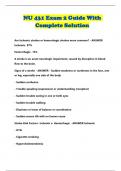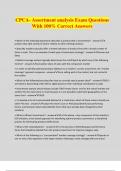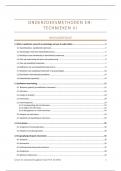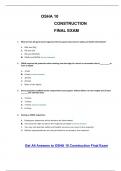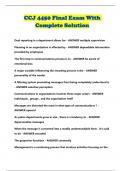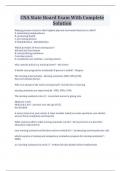Quantitative Research and
Statistics
PSYC2005 | Block 2
1 QUANTITATIVE RESEARCH
1.1 GENERAL OVERVIEW
Quantitative Research explores phenomena through the formal and systematic
collection and analysis of numerical data.
• Quantitative research relies on creating knowledge by directly observing human
behaviour and experiences and representing these observations as numbers; this
numerical data is then analysed to find patterns or trends that can be turned
into generalizable knowledge claims.
Empiricism and quantification of constructs lie at the heart of quantitative research.
• Empiricism is an epistemological theory (theory of knowledge) that suggests
that human knowledge and understanding should be based on independently
verifiable information gained through the senses (i.e., what is observed or
experienced).
• Quantification is a process whereby numerical representations of human
experiences and observations are produced through measurement (the
assignment of quantities/numbers).
1.1.1 Quantitative Research Questions
Three types of questions are common in quantitative research and represent different
intentions or aims that it plans to address. This can also be considered a type of
quantitative research.
Descriptive Questions
• Aim to describe the characteristics of existing phenomena.
o How much of variable X is present in population/group A?
o How often does phenomenon X happen in population A?
Correlational Questions
• Aim to examine the nature of the relationships between variables.
o What is the nature of the relationship/s between the values of variables X
and Y?
o To what extent can the value of variable Y be predicted by the value of
variable X?
o Is there a difference between groups A and B on variable X?
Experimental Questions
• Aim to test for cause-and-effect relationships between variables.
o Does variable X cause/affect variable Y?
,2561969 – Quantitative and Statistics Notes – PSYC2004A
1.1.2 Quantitative Research Characteristics
For all three types of quantitative research:
Purpose
• To establish, confirm, or validate levels of observed variables and/or the nature of
relationships between observed variables.
• To allow for explanation, prediction, and control of phenomena
• To allow for the development of generalizations that contribute to theory
formation across different populations and contexts.
• To test the theory
Process
• Establishing and defining different elements of the study (questions, variables,
sample, instrument/ methods for data collection, analytic framework) before the
study is conducted.
• Creating carefully structured and systematic guidelines for the study that allow
for replication.
• Measuring the concepts of interest in the form of distinct variables using
standardised instruments.
• Attempting to remain as ‘objective’ as possible and avoiding ‘value-laden’
judgements i.e., adopting a detached view.
• Research should never have a “this is going to be the result” mindset.
Data Collection
• Begins with the identification and isolation of specific variables of interest in the
study as well as formulation of the research questions (and possibly a specific
hypothesis or set of hypotheses if relevant).
• Relates specifically to the variables of interest (theorisation – theoretical variable
and operationalisation); attempts may be made to control for or eliminate
extraneous variables (focused).
• Is standardised.
o The procedure and measures are pre-determined and carefully assessed to
establish reliability, validity, and bias.
o Does it have construct & ecological validity?
• Easily converted to numerical data.
o Nominal variables – numbers only
o Ordinal variable – it’s in order.
o Ratio variable
o Scale variable
• Occurs in reasonably large, ideally “representative” samples.
Data Analysis
• Is carried out by converting the data into numerical form and running statistical
analyses (descriptive or inferential).
• Is carefully evaluated using criteria to establish rigour, reliability, and validity;
ideally the researcher maintains an ‘objective’ role during the interpretation.
• Is typically situated in a deductive analytic framework i.e., begins with a premise
or hypothesis and draws logical conclusions from these (general to specific).
o Don’t seek something specific when doing research.
,2561969 – Quantitative and Statistics Notes – PSYC2004A
Reporting Findings
• Involves reducing the data to aggregated statistical information allowing for
average performance, trends, and patterns to be deduced.
• Occurs through formal, scientific reporting; writing is typically ‘neutral’ and
passive.
• Findings must be presented in a way that represents the truth as accurately as
possible. It must also be easy for someone to interpret the data correctly. No
misleading people.
1.1.3 Quantitative Research Paradigmatic Assumptions
• All three types of quantitative research are based on ontological (what exists for
people to know about – what we know), epistemological (how knowledge is
created and what is possible to know – how we know it), and methodological (the
methods – how we know it in extreme detail – research pov) assumptions drawn
from the positivist (objective reality) and post-positivist (sceptical of some aspects
of positivist, there is subjective) paradigms.
• A research paradigm is an accepted conceptual framework that outlines a set of
common beliefs about the nature of reality (ontology – theory of being), what can
be known about reality (epistemology – theory of knowledge), and how reality can
be investigated (methodology – theory of action).
• Typical ontological assumptions associated with quantitative research include:
o belief in an external, independent reality
o belief in determinism i.e., general laws exist that govern behaviour;
prediction and control based on understanding patterns are possible.
• Typical epistemological assumptions associated with quantitative research
include:
o belief in empiricism i.e., prioritisation of direct experience that can be
independently verified through observation and/or measurement.
o belief in a universal truth
o belief in objectivity i.e., researcher as the passive collector and expert
interpreter
• Typical methodological assumptions associated with quantitative research
include:
o belief in hypothesis testing i.e., postulate, test, and revise the model of
investigation.
o tendency to experimentation
1.1.4 Qualitative Research in South Africa
• When considering conducting quantitative studies in South Africa, there are
some important contextual considerations to keep in mind:
o Literacy o Education (level and
o Language proficiency quality)
o Culture (race, ethnicity, o Socio-economic status
home language) o Urban/ rural
o Acculturation o Resources and access
, 2561969 – Quantitative and Statistics Notes – PSYC2004A
1.2 SAMPLE AND SAMPLING
1.2.1 Sample and Population
• Sample: a subset of a population.
• Population: a group of potential participants to whom you want to generalise.
o Populations can be any size but are often used to refer to large groups.
• The characteristics you would expect to find across the different people in the
population are also present in the people in the sample.
• The larger the group, the harder it is.
1.2.2 Sample Selection
• The sample should have the best approximate characteristics of the population.
• External Validity: the extent to which a sample obtained is able to do this.
o Not making false claims because the sample is as accurate as possible.
• Sample should be large as possible.
• Important Considerations:
o Feasibility = access, practicality, time, and resource constraints.
o Diversity = sufficient variety (in characteristics, groups, divisions in
population)
o Suitability = required and analytic assumptions
▪ Perimetric Assumptions
1.2.3 Types of Sampling
There are two types of quantitative sampling:
• Non-Probability Sampling
o Selecting samples in a way that isn’t random.
o Advantages:
▪ Convenient
▪ Economical
▪ Practical
o Disadvantages:
▪ Unequal probability of selection between people
▪ No guarantee of diversity/ equal representation
• Probability Sampling
o The selection of the sample is random.
▪ Everyone in the population has the same probability of being
selected.
o Sampling frame: the researcher needs to obtain a list of all the elements
in the population.
o Advantages:
▪ Statistical guarantee that the characteristics of the different people
in the population are represented.
o Disadvantages:
▪ Lack of feasibility
▪ Impractical
• Practicality is limited to a small population.
▪ Resource intensive
▪ Breaks down if participates don’t want to participate.

